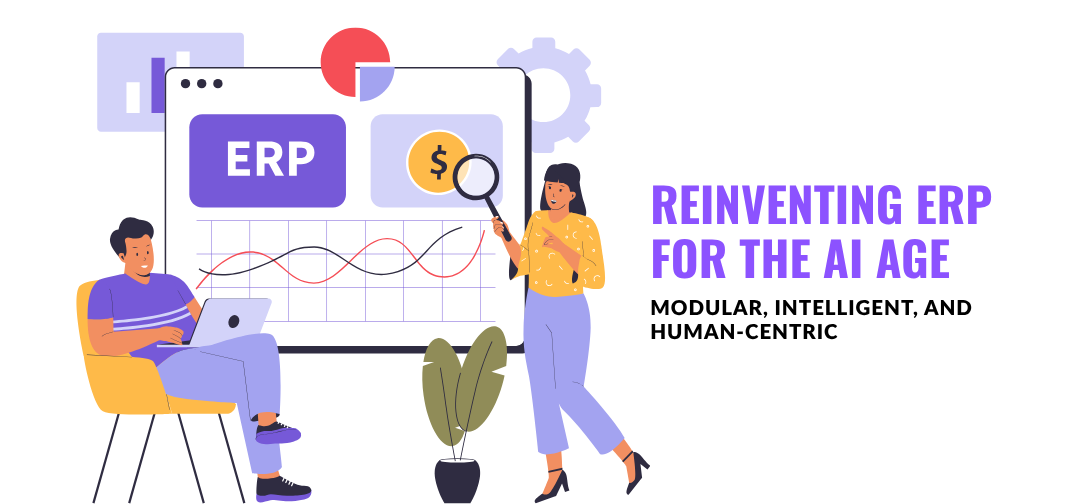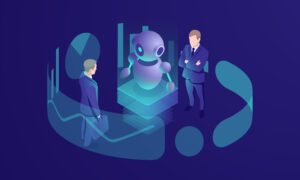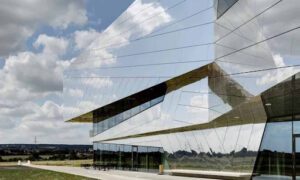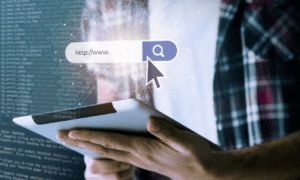For decades, Enterprise Resource Planning (ERP) systems have been the operational core of global businesses, unifying finance, HR, supply chain, and manufacturing under one digital roof. They delivered control, consistency, and standardization—qualities essential in a stable, predictable world.
But that world has changed.
Today, businesses operate in an environment defined by rapid disruption, global complexity, and real-time expectations. Traditional ERP, with its monolithic structure and rigid workflows, is no longer a competitive advantage. Instead, it often becomes a barrier to agility, innovation, and insight.
A new model is needed—one that’s modular, AI-native, and designed around how people and businesses actually work.
Why Legacy ERP needs a Reboot
Legacy ERP systems were designed for linear workflows and structured decision-making. They excelled in a world where change was incremental and processes were repeatable.
However, in modern enterprises, business models shift in weeks, supply chains adapt daily, and data volumes increase by the minute.
Yet legacy ERPs remain stuck in yesterday’s cadence.
Critical information is often locked in silos, inaccessible without manual extraction or IT intervention. Finance teams struggle to reconcile reports across systems. Procurement leads face lengthy workflows to reorder basic supplies. Operations managers lack real-time visibility into demand signals or resource constraints.
These are not just inefficiencies; they are strategic liabilities. When ERP becomes a bottleneck rather than an enabler, businesses lose time, clarity, and competitive edge.
From Recordkeeping to Reasoning: The Role of AI
The integration of artificial intelligence, huge language models (LLMs), is fundamentally transforming how ERP systems deliver value. Rather than simply automating routine tasks, AI-infused ERP systems can now interpret context, synthesize information, and surface insights in human language.
AI copilots are actively reshaping how enterprise users interact with their systems. They offer:
- Predictive planning: AI models forecast demand and adjust procurement dynamically
- Anomaly detection: Systems flag irregularities like compliance breaches or revenue leakage early
- Conversational access: Users query data in natural language, making insights accessible across roles
- Proactive recommendations: AI offers next-best actions based on real-time business signals
A noteworthy example is that of a global retail conglomerate that used AI to uncover a recurring overbilling pattern, weeks before auditors flagged it. The model not only identified the issue but suggested the root cause and potential process improvements, ultimately saving the company over $400,000 annually.
In this new paradigm, ERP doesn’t just record transactions. It reasons, advises, and empowers.
The Rise of Composable ERP
Alongside AI, a second trend is driving the evolution of ERP: modularity.
Traditional ERP systems are monolithic—built as all-in-one suites that require extensive customization and are difficult to upgrade. In contrast, composable ERP is built from loosely coupled, interoperable modules. Each component—be it for finance, inventory, HR, or analytics—can evolve independently while still integrating seamlessly with the larger architecture.
This shift enables organizations to:
- Roll out new capabilities in weeks, not quarters
- Integrate best-of-breed solutions without costly replatforming
- Experiment with emerging technologies like blockchain or low-code apps
- Reduce the total cost of ownership by minimizing custom development
A noteworthy example involved a manufacturing firm that did not need a complete ERP overhaul—just better forecasting. Instead of replacing their core systems, they deployed a standalone predictive analytics module that plugged directly into their finance stack. It went live in six weeks, delivering insights that improved production planning and inventory turnover.
Composable ERP aligns beautifully with AI, making it easier to plug in specialized models or automation engines where they’re needed most.
Human-Centered ERP: Built for People, Not Just Processes
Technology should conform to how people think and work, not the other way around. Yet many ERP interfaces remain clunky, rigid, and confusing. Training can take weeks, and adoption often requires top-down enforcement.
That’s why human-centered design is no longer optional. It’s a business imperative.
By analyzing actual user behavior and needs, ERP systems can be reimagined to fit real-world workflows. In one public sector implementation, redesigning key ERP screens based on user interviews and task analysis led to a 40% reduction in training time.
In another case, introducing voice-activated inventory queries allowed field technicians to check part availability hands-free, improving efficiency in remote locations.
When ERP systems feel intuitive and responsive, teams are more likely to adopt and utilize them, and subsequently productivity increases, resistance fades. Insights flow more naturally into decisions.
ERP at the Edge: Supporting Work Wherever It Happens
Business today happens everywhere. From remote warehouses to field operations to humanitarian relief zones, organizations require systems that can function in real-world conditions.
That’s why edge-ready ERP capabilities are critical.
Recent projects have included ERP deployments that operate with limited or no connectivity, powered by solar energy or satellite internet. In one humanitarian case, an ERP solution enabled logistics coordination across five disaster zones, without reliance on a central data center.
Edge-capable ERP ensures:
- Continuity of operations in unpredictable environments
- Real-time data capture from field teams
- Greater resilience during outages or low-bandwidth situations
As remote work and distributed operations become the norm, the ability to operate at the edge will define the next generation of business platforms.
ERP as a Modern Operating System
The transformation of ERP is not just technical. It is also strategic. Forward-thinking companies are recasting ERP not as a static system of record, but as the intelligent operating system of the enterprise.
To meet this mandate, ERP must be:
- Modular – to scale and evolve with the organization
- AI-native – to deliver proactive, contextual intelligence
- Human-centric – to reflect how people truly work
- Edge-ready – to support business wherever it happens
Early adopters of this model are already seeing results. A financial services firm deployed jurisdiction-specific compliance updates in days using a modular design. A consumer goods company improved forecast accuracy by 30% with predictive AI modules. These are not outliers—they are the beginning of a broader shift.
What Comes Next
The real risk is building on platforms that can’t evolve. Legacy ERP systems may still be functional, but they’re increasingly misaligned with how modern business operates.
The next generation of ERP will be adaptive, intelligent, and people-first. It will empower teams, not slow them down. It will also enable faster innovation, sharper insight, and more resilient operations.
For organizations still relying on ERP systems that haven’t changed in five years, the question isn’t whether to modernize—it’s how soon they can start.
About the Author
Shyam Ravindranathan is a senior product leader with deep expertise in enterprise cloud applications in domains ranging from Supply Chain, Manufacturing, IoT, Blockchain, and PaaS. Currently, he leads the product efforts in building AI-enabled compliance applications for the enterprise. With a career spanning global markets and multiple patents in AI, ML, and Blockchain systems, he helps organizations build and scale technology initiatives that deliver measurable outcomes.



































